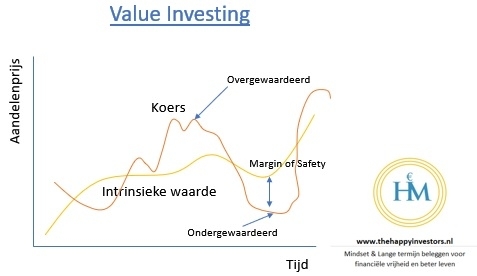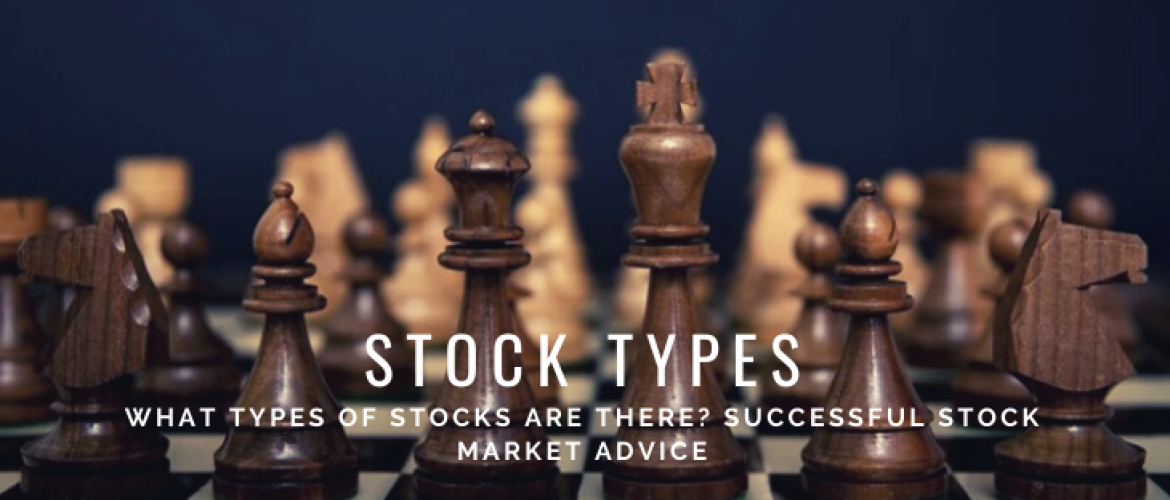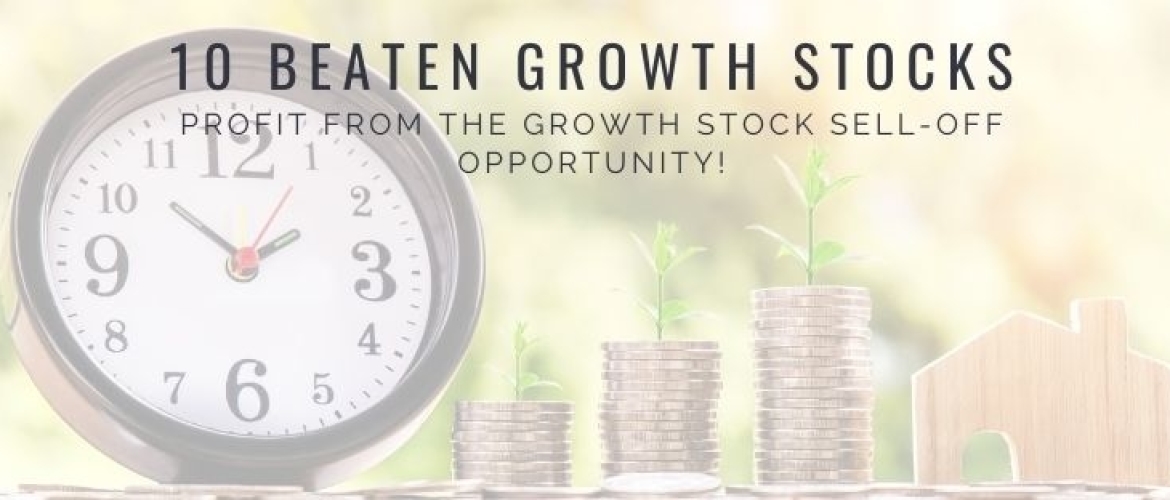Dear Happy Investor, do you know what types of stocks there are? This is important basic knowledge to successful investing. After all, if you know the different types of stocks you can profit from them. Certain types of shares perform significantly better in the long term! This is crucial information. You want to invest mainly (but not only) in the best type of stocks. On the other hand, it is also important that you apply a proper spread between these types of shares. For example, in some periods, growth stocks perform better than value stocks. These periods can last up to ten years (or longer).
What types of stocks are there? This article explains and provides tips for successful investing in the different types of stocks!
Contents:
What types of stocks are there? Successful Stock Market Advice
Different types of stocks with different returns
Types of Stocks: Value and growth stocks
Small and large cap stocks
Different type of stocks: Loser and winner stocks on the long term
Types of stocks based on Momentum: stocks of losers and winners in the short term
Types of stocks based on profitability
Different types of stocks with different returns

There are different types of stocks. Below is a summary:
- Value shares (beware of the Value trap)
- Growth stocks (these can also be Value stocks)
- Large vs. small shares based on market capitalization
- Dividend stocks
- Penny Stocks (often bad investment!)
- Cyclical and momentum stocks
- REITs (real estate funds as stocks)
On average, some of these types of stocks perform better over the long term.
As an investor, you can exploit these opportunities. In this article, you find an overview of these types of stock that exist in the financial market. Of course, you can classify stocks in dividend and non-dividend paying, small, mid, and large cap. But, the list below is different from the typical classifications. Specifically, the list contains types of stock together with trading strategies that you can exploit as an investor to earn higher returns, on average – please remember that we base ourselves in finance on probability theory and statistics, so the results hold on average. For a long-term investor with a long-term perspective, the strategies should remain valid. Sounds good, right? Let’s dive in.
You can buy Stocks and ETF’s commission-free at eToro via this link
Types of Stocks: Value and growth stocks

First of all, let’s distinguish between value and growth stocks. You can identify such stocks easily yourself by finding the book and market values of the company. The book value is the net value of a firm’s assets as found on their balance sheet: the company’s earnings, cash flows or dividends. The market value is the company’s value based on the outstanding shares in the market: simply the price of the stock.
Stocks with high ratios of book value to market value are so-called value stocks. Less formally, and as a rule of thumb, value stocks are often mature, well-known companies that are leaders in their industry with a great deal of price stability. Examples are Apple, Johnson & Johnson, and Walt Disney. Growth stocks, on the other hand, have low ratios of book to market values. Growth stocks are often young and growing companies, which tend to have higher risk levels.
Now, the interesting part starts: value stocks tend to earn substantially higher average returns in the long run than growth stocks. The difference in returns earned by value stocks with high book-to-market values and growth stocks with low book-to-market values is the value premium. The value premium is historically large. Recent estimates (Guo and Wachter, 2019) show that the value premium equals 7.19% per year from 1952 to 2017. In other words, if you invested for roughly 70 years in value stocks rather than growth stocks, then your return would be 7.19 percentage points higher annually! Using a strategy that reinvests your yields, exploits this additional return tremendously.
Commission-free Crypto, Stocks and FOREX Trading with NAGA
Do you want to trade Bitcoin, Crypto, Stocks, and Forex? NAGA is one of the biggest all-in-one crypto brokers where you can buy crypto 100% commission-free. You can also use the AutoCopy to copy the Top Traders of NAGA. In fact, you can even become a Top Trader yourself and earn up to 10.000 dollars a month if you are really good at it. Anyway, this broker is perfect for anyone who wants to trade crypto 100% commission-free. You can set up an account for free and try it out.
Want to know more? Click for more information
The true definition of Value Investing

The true essence of Value Investing is to buy good companies below intrinsic value (preferably with margin of safety). This means that even small growth companies can still be a value stock. There aren’t that many of these, but they do exist.
Suppose you have a growth stock that is not yet making profits, but has very high sales growth. If this company starts to make profits much sooner than expected, this is a Value stock. This works like this: let’s assume that the market expects growth stock X to make profit Y in five years. You can buy the stock now at price Z. If recent reports show that growth stock X will make profit Y in three years, at that time the price will rise to Z + 1.
Investing in large, profitable companies below their intrinsic value is the most familiar form of Value Investing. But this does not exclude growth stocks!
Small and large cap stocks
Secondly, we distinguish between stocks with smaller market capitalizations and stocks with larger market capitalizations. The market capitalization can be easily found from, because is simply equals the stock price multiplied by the number of outstanding stocks. Historically, small market cap stocks tend to outperform large market cap stocks. We call this the size premium. Fama and French (1992) show that for the period of 1963 to 1990 the average return of small cap stocks is 0.74% per month higher than large cap stocks. This is certainly worth to consider exploiting as a long-term investor: a possibility to benefit from the size premium is to buy small market cap stocks.
An example to profit from this is to buy & hold the Russell 2000 ETF.
Happy Investors Recommendation: Higher Return and Lower Risk? Tip: Asymmetrical Investing!
What if you could get higher stock returns while having less risk. Sounds too good to be true? It’s not if you know how to start with asymmetric investing. These are investments where the potential gain is greater than the potential loss. The only way for asymmetric investing is if you have a lot of knowledge and experience. This is for advanced professionals and is also used in the largest mutual funds with a minimum deposit of millions.
I’m not an expert in asymmetric investing, but I do know a very good party named Capitalist Exploits which I highly recommend. I’ve joined their Membership one year ago and it brings a lot of value for unique investment opportunities with commodities. I’m talking about +300% gains on Uranium, Copper, Agriculture, and 60+ buying opportunities. The Membership brought me a significant return on investment! These are true professionals. In addition, they also have a free newsletter where they share masterful tips and research on asymmetric investing with us once a week.
Want more information? read my full Capitalist Exploits Review and Experiences
Different type of stocks: Loser and winner stocks on the long term
Thirdly, we can exploit long-term reversals in the financial market by considering “loser” and “winner” stocks, or even portfolios. Suppose you consider stocks that are listed on the NYSE, and that you rank them based on their prior three year returns. A loser stock, or portfolio, is defined as a stock or portfolio that yields the lowest returns based on these prior three year returns. A winner stock, or portfolio, is a stock or portfolio that has the highest returns based on these prior three year returns.
You can use the stocks on the NYSE to determine losers and winners but, of course, you can use any other stock index from which you consider buying shares (i.e., NASDAQ, SP500). Historically, De Bondt and Thaler (1985) find that for the period of 1926 to 1982 the average annual return of the loser stock (or portfolio) is higher than the average return of the winner stock (or portfolio) by almost 8% per year if you hold the loser and winner stocks for three years!
Again, you can exploit this sizeable premium by forming a trading strategy. Each year, you sort stocks based on losers and winners with the prior three years of return, and you could benefit on average by buying the losers and holding them for three years. As such, you exploit long-term reversals in the market. Please note that this strategy is a long-term trading strategy.
Personally, we would not use this strategy. It makes more sense for us to stay focused at all times on the fundamental value of the types of stocks we buy. We are investors in companies. We invest only in the best companies with unique strategies and strong management. Our preference is for companies with relatively high profit margins (see below).
Let Money Work for You! Starting on the best investment platforms is half the battle
Are you still working hard for your money? Why don’t you consider letting the money work for you! Create passive income and attain financial freedom. Starting on the best investment platforms is half the battle. Do you want to know what the very best investment platforms are? Then click on the blue link to compare the best investment platforms now. Here you can read my independent comparison of the best online brokers for stocks, crypto, and P2P. Save money and choose the best investment platform!
Types of stocks based on Momentum: stocks of losers and winners in the short term

Also, you can exploit short-term reversals in the financial market by again considering “loser” and “winner” stocks. However, now you rank the “loser” and “winner” stocks by sorting on the prior six months return and you hold the stocks for six months, rather than the three year returns and holding period as described above. Estimates show that the winners outperform the losers by an average of 10% on an annual basis! This robust finding in the financial markets is known as momentum.
Comparing to long-term reversal, these results show that the length of the prior ranking period and the holding period plays a crucial role in determining your type of stock and, consequently, your investment strategy.
The combination of short-term undervaluation (value) and momentum can lead to high returns. Certainly if these are companies that also realize (profit) growth.
Please be aware that the momentum approach is less suitable for passive investors, since it requires to rebalance every half year.
Types of stocks based on profitability
Recently, the finance profession and academic literature has devoted much attention to the new “profitability premium”. “Profitable” firms generate significantly higher returns than “unprofitable” firms. Here, profitability is measured by using accounting standards. A profitable firm has a high gross profits-to-assets (GPA) ratio: divide the firm’s gross profits by the firm’s total assets. As a rule of thumb, profitable stocks tend to be growth stocks: they expand quickly.
Using the period from 1962 to 2010, Novy-Marx (2012) finds that profitable firms earn on average returns 0.31% per month higher than the least profitable firms. Strategies built on profitability are growth strategies and, as such, provide an excellent hedge for the value-premium strategy (see above).
Interestingly, the profitably strategy is the technique that the famous trader Warren Buffet has been using, without knowing himself. Novy-Marx’ research helped explaining Buffet’s superior performance: namely, Buffet unconsciously bought stocks with a high profitability.





![What is the best thing to invest in? Stocks to Crypto [2022]](https://media-01.imu.nl/storage/thehappyinvestors.com/4861/what-is-the-best-thing-to-invest-in-2560x1100.png)


